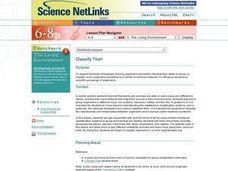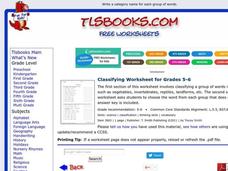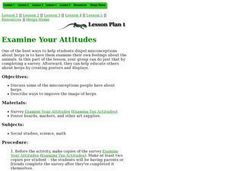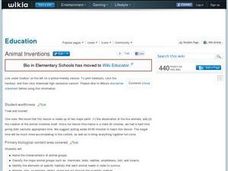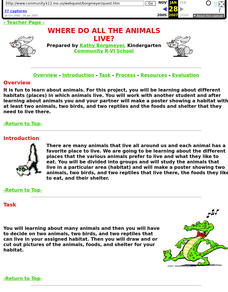Curated OER
Prairies
students make booklets about each of the following: reptiles, birds, plants, animals and buffalo. Each was information and contained the facts covered in class. they research one specific area in which they were especially interested....
Curated OER
Classify That!
Students get acquainted with diverse forms of life by using modern biological classification systems to group animals that are related. They explore basic scientific groupings like genus, species, mammals, fish, birds, amphibians, and...
Curated OER
Classify That!
Learners explore diverse forms of life by using modern biological classification systems to group animals that are related. Students then study basic scientific groupings like genus, species, mammals, fish, birds, amphibians, and...
Curated OER
Classifying
In this classifying worksheet, students observe a group of words, analyze their similar characteristics and then give them a classification. Groups of words include items such as vegetables, reptiles, landforms, conifer trees,...
Curated OER
Classifying into Categories
In this classification worksheet, students organize their thoughts by classifying the words from the box into the following categories: birds, mammals, reptiles, and fish.
Curated OER
Sorting and Graphing Animals
Learners inquire about animals using SIRS Discoverer or eLibrary Elementary. For this organizing data lesson, students sort pictures of animals in various ways and develop graphs. Learners locate a mammal, reptile, fish, insect or...
Curated OER
Animal Classification
Young scholars recognize the six groups of animals (Mammals, fish, birds, reptiles, amphibians and arthropods) and their characteristics. In this animal characteristics instructional activity, students sort animals by their...
Twisty Noodle
Mammals Book
What do a sheep, a boy, and a bat have in common? Learn about mammals with a mini book that lists many different types of mammals. Kids can color the fun illustrations and compile the pages to publish their own mammal books.
Curated OER
Herps and Humans
Students compare and contrast the similarities and differences between the internal organs of herps--reptiles and amphibians--and humans.
Curated OER
Examine Your Attitudes
Students complete a survey about their attitudes toward herps--reptiles and amphibians. They compare their findings, tally them, graph them, and administer the survey to others. Later, they create an education campaign to dispel myths...
Curated OER
Steppin' Out: Using Inquiry to Challente Alexander's Stride Analysis
High schoolers distinguish between walking, jogging and running trackways in humans. They analyze the phylogenetic progression of the leg position as described by pace width and angulation, comparing amphibians, reptiles and mammals....
Curated OER
Animal Inventions
Students name the characteristics of animal groups. Students classify the major animal groups such as: mammals, birds, reptiles, amphibians, fish, and insects. They identify the elements of specific habitats that each animal needs in...
Curated OER
NS 6: Monerans, Viruses
Students compare the structures and functions of viruses and bacteria relating their impact on other organisms. They review the main vertebrate groups. Students are describing the characteristics of the main group of vertebrates: ...
Curated OER
What's a Mammal?
Learners research his or her assigned mammal using print and online resources. In this mammals research instructional activity, students discover mammals have certain traits that distinguish them from animals in other classes, such...
Curated OER
Animals Vocabulary Wheel
In this animals vocabulary worksheet, students write the definition for animal vocabulary words in this wheel. Students write definitions for amphibian, predator, reptile, and adapt.
Curated OER
The Animal Kingdom of Vertebrates
Seventh graders classify fish according to their characteristics. In this classification lesson plan students learn how to group animals including birds, reptiles and amphibians.
Curated OER
Where Do All the Animals Live?
Students study animal habitats and make a poster showing two animals, two birds, and two reptiles in their habitats.
Curated OER
Toadstones, Snake Gods, and Divining Turtles
Students research facts about herps--reptiles and amphibians. They choose one or more facts to illustrate and create a drawing to be displayed.
Curated OER
Animal Playing Cards
Young scholars research animal characteristics including information about mammals, reptiles, birds, and fish. They place the information into a database and then, create playing cards using the information.
Curated OER
Learning About Animals' Bodies
Students research different animals (mammals, reptiles, amphibians, insects, birds, fish) and create books, murals, dioramas, puppets, and sculptures to illustrate the necessity of various body parts for overall survival. In this animal...
Curated OER
Turtle and Tortoise Preschool Lesson Plan
One of the best parts about teaching the littlest learners is that you can create thematic lessons that use one topic to address every subject. Here is a nice set of thematic teaching ideas that uses turtles and tortoises to teach...
Curated OER
Design an Exhibit
Students play the roles of exhibit designers in a zoo as they create a new exhibit for herps--amphibians and reptiles. They consider all the needs--light, heat, etc.
Curated OER
Animal Types
In this animal vocabulary activity, students categorize the list of animals according to their type: mammals, birds, reptiles, amphibians, fish, and insects.
Curated OER
V for Viper
In this viper worksheet, students read several different texts about vipers. Students learn facts about the reptile as well as read poetry.
Other popular searches
- Reptiles and Amphibians
- Reptiles Worksheets
- Reptiles Life Cycles
- Reptiles Hands on Activities
- Reptiles Amphibians
- Amphibians and Reptiles K 2
- Reptiles & Amphibians
- Marine Reptiles
- Reptile Excretory System
- Reptiles Lesson Plans
- Reptiles Introduction
- Collections on Reptiles




